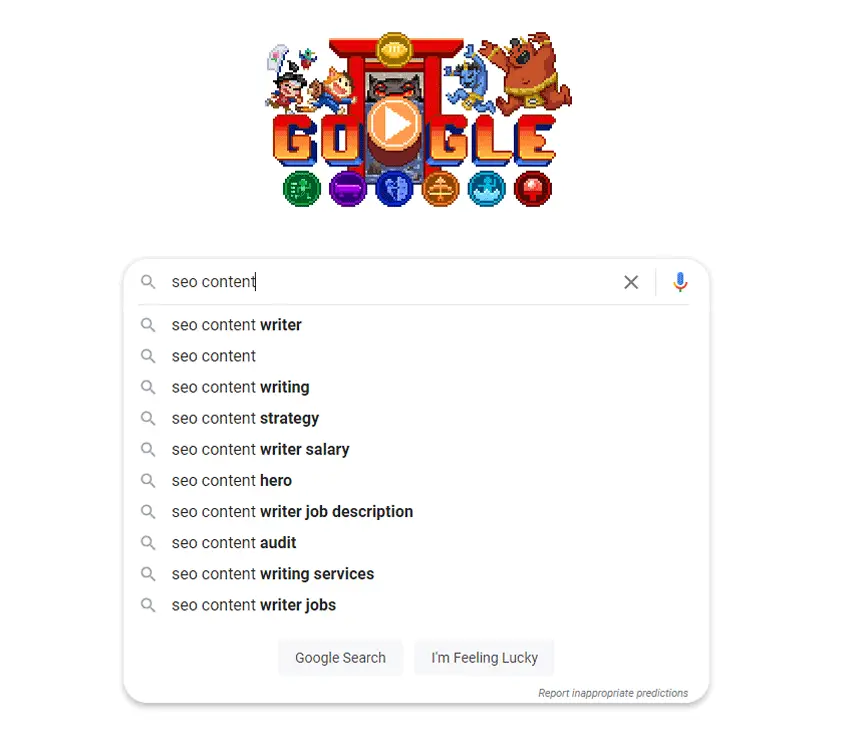In this post, we’ll answer the question, “what is SEO content?”
But we’ll also take it a step further than just the definition and meaning.
Below, you’ll also find out why is SEO content important for rankings and how to write SEO content for your website.
The goal here is to help you understand every aspect of how content and SEO work together to improve the visibility for your site in the search engines.

What Is SEO Content?
SEO content is online content that helps your web pages rank higher in the search engines. Examples of a good SEO content strategy include SEO-friendly blog posts, guides, infographics, product pages, and trending content. Content that’s written for SEO increases the quantity of organic traffic to your website.
Why Is SEO Content Important?
SEO content is important because improves your website’s visibility in the search engines. Writing SEO content that’s relevant to a search query will affect how high it ranks for that keyword. Optimization in SEO content is important for any business that depends on organic search traffic for customers.
Types of SEO Content
Blog Posts
Blog posts are the most common type of SEO content. You can write about any topic you want that’s related to your niche and target a wide variety of keywords to get targeted SEO traffic to your website.
Blog posts are also the underlying framework for a good pillar cluster content strategy.
Guides
Guides are typically long-form content written for SEO purposes. They generally include how-to information, detailed steps, tips, or ideas on a topic related to your industry.
Infographics
Infographics are a popular type of SEO content that attracts backlinks and social media shares. Putting a large amount of data in a visually appealing graphic gives people a quick snapshot of information that’s easy to consumer and share.
However, the text embedded in the image cannot be indexed by Google, so it’s important to include content on the page and optimize it for SEO to get organic search traffic to it.
Product & Service Pages
Product and service pages are required content for online businesses and e-commerce stores. A good product or service page will have good SEO content to attract website visitors and effective copywriting to persuade visitors to take the next step in completing a sale.
SEO copywriting is best used for product and services pages because you want the content to rank in search engines and convert visitors into customers. Check out my post on what is SEO copywriting to learn more about this style of writing.
Trending Content
Trending content is a good type of content for SEO purposes because you can get quickly noticed through the hot topics of the day or week. Although this content doesn’t last long, the popularity can often be enough to drive a significant amount of traffic to your website in a short period of time.
The best way to use trending content in SEO is through “newsjacking”, which is a tactic of injecting your brand into the major headlines of the day or week by finding a popular story that’s getting a lot of buzz and providing your own analysis or opinion to get noticed.
Now that you know the definition for what is SEO content, why it’s important, and the most common types, we’ll now go over the steps for how to write it well.
How to Write SEO Content
1. Choose a Content Topic
The first step to writing SEO content is to choose a good topic to write about, as explained in my other post on what is SEO content writing.
This topic should be directly related to your industry or niche so you can get the right type of visitors to your website. So think of content ideas that your target customer cares about.
2. Find the Right SEO Keywords
Once you have a relevant topic for your SEO content, the next step is to find a set of keywords with traffic potential.
You don’t want to write content just for the sake of writing content.
Instead, you want to write content that people are actively searching for each month.
A simple way to find out what those keywords are is to go to Google and start typing in words that are related to your topic. Google will then autosuggest keyword phases that its users are actively searching for in the search engine.
Below is an image of this process in action as I type the words “SEO content”.

Another tool you can use for keyword research is a tool like KWFinder by Mangools (try it for free). It’s one of the only SEO tools I recommend as an affiliate because it’s cheap, yet powerful for keyword research.
With KWFinder, you can type in a seed keyword and get a list of other related terms people are actively searching for on Google. This takes the guesswork out of finding good keywords to target in your SEO content. And it helps you find ideas for other articles to write about.
The image below shows an example of using KWFinder to find related keywords to the phrase “what are organic keywords”, which is an article I wrote around the topic, “what does organic keywords mean?“

3. Analyze the Competitors
The next step for how to write SEO content is to look at the top-ranking pages for your target keywords. Analyze the top 3-5 competitors to see what type of content they’re including on the page in subheadings like H2 and H3 tags.
Your goal is to find the overlapping content that each site is writing about on the topic and include that same information on your page. This process will also ensure that you’re meeting the search intent of the user.
For each query (or keyword), Google delivers specific types of content to the searcher. For example, a person searching for the phrase “what does organic search mean” is looking for a definition; not a list of tips on how to increase organic traffic to a website.
Therefore, you need to make sure your content is meeting the needs of the searcher. And the best way to do that is to examine the top-ranking pages for clues and ideas about what content you need to include on the page.
4. Write the SEO Content Outline
After you’ve analyzed the pages of your competitors, the next step in writing SEO content is to create an outline for the information.
Write the headlines for each major section you’re going to be covering in the content and put them in H2 tags. You can see how I did that in this article by scrolling back up and opening the table of contents.
If you need to add additional details under an H2 heading, use an H3 for the sub-topic information. You can see how I did that right here in step 4. Step 4 is an H3 subsection of the main H2, “How to Write SEO Content”.
5. Write the Draft
Once your outline is complete, you can start writing the body copy for your content.
The best way to write SEO content is to write comprehensive content. Make it better than the top-ranking competitors by giving the person who is searching for a keyword everything they need under each section.
Also, try to write long-form content. The longer the content is, the more SEO opportunities you’ll have and it increases the number of total keywords the page ranks for.
6. Optimize the Content for SEO
After your content is fully written, the next step is to optimize it for SEO.
On-page SEO is a tricky subject, but you can get some quick results by adding your keyword to a few elements on the page and in the HTML code.
I’ll share a few of those locations below to help you get started with your content:
- Meta Title
- Meta Description
- URL
- Header Tags
- Body Content
Just keep in mind that each of these areas must be optimized in a specific way. Otherwise, you may over or underoptimized for your target keywords, which can make it more difficult to rank.
If you want to master the art of on-page SEO, I encourage you to check out my course. No one else teaches this strategy in such a comprehensive manner in the same way that I do.
7. Add Images to the Page
Images are another way you can optimize content for SEO.
Good SEO content will include at least one image for every keyword you’re targeting.
To optimize your images correctly, put your target keyword in these locations:
- Image filename
- Image ALT text
- Image title attribute
- Image metadata
8. Publish Your Written Content
After you’ve written and optimized your SEO content, it’s time to publish it.
9. Submit the Page to Google Search Console
Once the SEO content is live on your website, go to Google Search Console and submit the URL for indexing. This step will speed up the process of getting your web page indexed in Google’s search engine.
Just copy and paste the URL into the field at the top of the Google Search Console dashboard. Then hit the enter key. A new page will then load with a link called “Request Indexing”. Click on it to alert Google to crawl the new page.

10. Write the Next Piece of Content
Congratulations! You now know how to write SEO content.
It’s now time to get started on your next article by following steps 1-9 again. You can also check out this related guide on how to write an SEO friendly article to find even more tips for content optimization.

What Does Content Mean In SEO?
Content in SEO means the writing and structuring of SEO-friendly content for a website. SEO cannot work without good content. What content means for SEO is that it’s written well, meets the search intent for the user, and is properly optimized to rank higher in the search engines.
What Comes First Content or SEO?
Content comes first, then SEO. Search engine optimization is best applied to content after it has been written. A good strategy is to write the content first, then do SEO to optimize the content for search engines. This process creates content that satisfies both the user and the search engines.
What Is SEO Optimized Content?
SEO optimized content is content that is optimized for search engines. Content that has been SEO optimized has a better chance of ranking in the search engine results pages (SERP) for its target keywords. Any information that lives on the web can be optimized for SEO purposes.
See my post on what are SEO strategies to learn more about this topic.
SEO Content Summary
I hope you enjoyed this guide on what is SEO content.
As you discovered, the main reason for why is SEO content important is that it helps your web pages rank higher in the search engines so your business can get more visibility. And with that visibility comes higher levels of traffic, customers, and sales.
By following the steps for how to write SEO content outlined here, you can increase your chances of getting found in Google, Yahoo, and Bing.

SEO Chatter is dedicated to teaching the fundamentals of search engine marketing to help marketers understand how to increase organic website traffic and improve search engine rankings.
